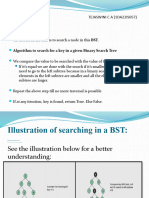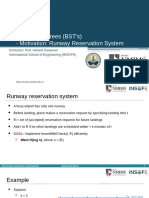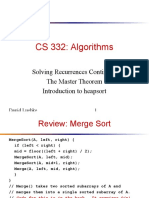CE-C-42 BINARY SEARCH TREE
Student Details : Jainam Shah
Div : C
Faculty : A/Prof. Subject Name
Silver Oak College Of Engineering and Technology,
College of Technology, SOU
INTRODUCTION SYSTEM FLOW with Experiments and Results
A Binary Search Tree (BST) is a data structure in which each node has at most Here is a simplified outline for a system flow with experiments and results
two children (i.e., left child and right child) in a Binary Search Tree (BST) PPT:
• Each node represents a key (or value). Slide 1: Introduction
• All the keys in the left subtree of a node are less than the key in the node. • Title: Binary Search Tree (BST) Implementation
• All the keys in the right subtree of a node are greater than the key in the • Brief overview of BST
node. Slide 2: System Flow
GOALS & OBJECTIVES • Create nodes and insert into tree
• Search for a value in the tree
Goals: • Perform traversals (inorder, preorder, postorder)
Slide 3: Experiment 1 - Node Insertion
• Efficient Data Retrieval • Insert nodes into the tree
• Dynamic Data Management • Verify BST property is maintained
• Show resulting BST
Objectives: Slide 4: Experiment 2 - Search Operation
• Minimize Search Time • Search for a value in the tree
• Verify correct node is returned
• Maintain Data Integrity • Show search result
Slide 5: Experiment 3 - Traversal Operations
• Perform traversals (inorder, preorder, postorder)
TECHNIQUES USED • Verify nodes are displayed in correct order
• Show traversal results
Here are some common techniques used in Binary Search IMPLEMENTATION
Trees (BSTs):
Define the node structure Insert Node Search Node:Delete Node Balancing the Tree Traversal Methods( in order , preorder , postorder )
#include <stdio.h>
#include <stdlib.h>
1 : Insertion Techniques typedef struct Node {
int data;
struct Node* left;
2 : Deletion Techniques struct Node* right;
} Node; Node* createNode(int data) { Node* newNode = (Node*)malloc(sizeof(Node));
3 : Balancing Techniques newNode->data = data;
return newNode;
newNode->left = newNode->right = NULL;
} void inorderTraversal(Node* root) {
4 : Traversal Techniques if (root) { inorderTraversal(root->left);
printf("%d ", root->data);
5 : Searching Techniques
ALGORITHM USED inorderTraversal(root->right);
} }int main() { Node* root = createNode(1);
root->right = createNode(3);
root->left = createNode(2);
printf("Inorder Traversal: ");
inorderTraversal(root);
printf("\n");
return 0;
}
FUTURE SCOPE
Image of website Future Scope of BSTs:
• Big Data and Data Analytics
• Artificial Intelligence and Machine Learning
• Database Systems and Query Optimization
• Cybersecurity and Data Protection
• Internet of Things (IoT) and Real-Time Systems
• Quantum Computing and Hybrid Data Structures
CONCLUSION
Binary Search Trees (BSTs) are a fundamental data structure
in computer science, offering an efficient way to store and
retrieve data. With their ability to balance themselves and
maintain a sorted order, BSTs provide fast search, insertion,
and deletion operations.
REFERENCES
Online Resources:
• GeeksforGeeks: Binary Search Tree (BST)
(https://www.geeksforgeeks.org/binary-search-tree-set-1-search-
and-insertion/)
• Wikipedia: Binary Search Tree
(https://en.wikipedia.org/wiki/Binary_search_tree)
• MIT OpenCourseWare: 6.006 Introduction to Algorithms
(https://ocw.mit.edu/courses/electrical-engineering-and-computer-
science/6-006-introduction-to-algorithms-fall-2011/)






















































































